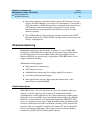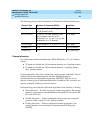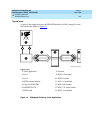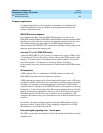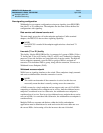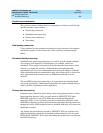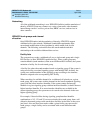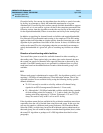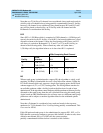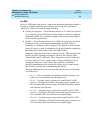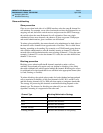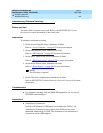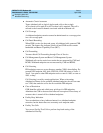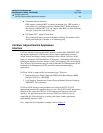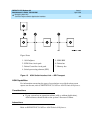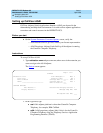
DEFINITY ECS Release 8.2
Administrator’s Guide
555-233-506
Issue 1
April 2000
Managing data calls
429Wideband Switching
15
Note that on a T1 facility, a D-channel is not considered a busy trunk and results in
a facility with a D-channel always being partially contaminated. On an E1 facility,
however, a D-channel is not considered a busy trunk because H11 and H12 calls
may still be placed on that facility; an E1 facility with a D-channel and idle
B-channels is considered an idle facility.
H12
Since H12 is 1,920 Kbps which is comprised of 30 B-channels, a 1,920-kbps call
can only be carried on an E1 facility. As with H11, the hunt algorithm uses a fixed
allocation scheme with channel 1 being the fixed starting point. Hence, an H12
call always is carried on B-channels 1 to 15 and 17 to 31 on an E1 facility (as
shown in the following table). When offered any other call (other than a
1,536-kbps call), the algorithm behaves as it does when H11 is optioned.
H0
When a trunk group is administered to support H0, the algorithm to satisfy a call
requiring 384 Kbps of bandwidth also uses a fixed allocation scheme. Unlike the
H11 fixed scheme which only supports a single fixed starting point, the H0 fixed
scheme supports 4 (T1) or 5 (E1) starting points. The H0 algorithm searches for
an available quadrant within a facility based on the direction of trunk or hunt
administered. If the algorithm cannot find an available quadrant within any facility
allocated to this trunk group, then the call is blocked from using this trunk group.
Again, based on GRS administration, the call may route to a different trunk group
preference and be subject to another algorithm based on the wideband options
administered.
Note that a D-channel is considered a busy trunk and results in the top most
quadrant of a T1, B-channels 19 to 24, always being partially contaminated. This
is not true for NFAS.
If this H0 optioned trunk group is also administered to support H11, H12, or N x
DS0, then the system also attempts to preserve idle facilities. In other words, when
offered a narrowband, H0, or N x DS0 call, the system searches
partially-contaminated facilities before it searches to idle facilities.
DS0s Comprising Each Channel
Facility
ISDN
Interface H11 H12
T1
T1
23B + D
24B (NFAS)
-
1-24
-
-
E1
E1
30B + D
31B (NFAS)
1-15, 17-25
1-15, 17-25
1-15, 17-31
1-15, 17-31



